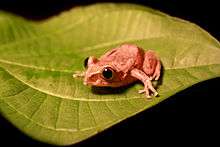Gaboon forest tree frog
The Gaboon forest tree frog, Leptopelis aubryi, is a species of frog in the family Arthroleptidae.[1][2][3][4] It is found in southeastern Nigeria, Cameroon, Central African Republic, Equatorial Guinea, Gabon, Republic of the Congo, western and northern Democratic Republic of the Congo, and the Cabinda Enclave of Angola.[1][2]
| Gaboon forest tree frog | |
|---|---|
 | |
| Scientific classification | |
| Kingdom: | Animalia |
| Phylum: | Chordata |
| Class: | Amphibia |
| Order: | Anura |
| Family: | Arthroleptidae |
| Genus: | Leptopelis |
| Species: | L. aubryi |
| Binomial name | |
| Leptopelis aubryi (A.H.A. Duméril, 1856) | |
| Synonyms[2] | |
|
Hyla punctata Hallowell, 1855 "1854" | |
Etymology
The specific name aubryi refers to Charles Eugène Aubry-Lecomte, a French colonial administrator and an amateur naturalist.[5]
Taxonomy
Leptopelis aubryi is similar to Leptopelis spiritusnoctis (referred to as Leptopelis hyloides prior to 2007) from West Africa, and they have sometimes been treated as conspecific. However, acoustic (male calls) and genetic data support their treatment as separate species. In fact, the large variation of call characteristics in L. aubryi could indicate that the current delimitation of this species might hide a complex of cryptic species.[6]
Description
Adult males measure 33–39 mm (1.3–1.5 in) and females 44–54 mm (1.7–2.1 in) in snout–vent length. The dorsum is brown and has an occipital triangle and rounded lateral spots. There are small, dark points present on the flanks, especially in the groin, and often small, white spots on the back and limbs.[4]
Habitat and conservation
Leptopelis aubryi is an arboreal species living in a range of habitats: secondary forests, swamp forests, and also degraded habitats (farm bush) outside forests. The eggs are laid in a nest, buried in mud near swamps and pools where the tadpoles later develop.[1]
Leptopelis aubryi is an adaptable and reasonably common species. It occurs in a number of protected areas, including the Korup National Park (Cameroon) and Monte Alén National Park (Equatorial Guinea). No significant threats have been identified.[1]
References
- IUCN SSC Amphibian Specialist Group (2013). "Leptopelis aubryi". IUCN Red List of Threatened Species. 2013: e.T56241A18387184. doi:10.2305/IUCN.UK.2013-2.RLTS.T56241A18387184.en.
- Frost, Darrel R. (2017). "Leptopelis aubryi (Duméril, 1856)". Amphibian Species of the World: an Online Reference. Version 6.0. American Museum of Natural History. Retrieved 21 December 2017.
- "Leptopelis aubryi (Duméril, 1856)". African Amphibians. Retrieved 7 November 2016.
- "Leptopelis aubryi". AmphibiaWeb: Information on amphibian biology and conservation. [web application]. Berkeley, California: AmphibiaWeb. 2008. Retrieved 7 November 2016.
- Beolens, Bo; Watkins, Michael & Grayson, Michael (22 April 2013). The Eponym Dictionary of Amphibians. Pelagic Publishing. p. 13. ISBN 978-1-907807-44-2.
- Rödel, Mark-Oliver; Emmrich, Mike; Penner, Johannes; Schmitz, Andreas & Barej, Michael (2014). "The taxonomic status of two West African Leptopelis species: L. macrotis Schiøtz, 1967 and L. spiritusnoctis Rödel, 2007 (Amphibia: Anura: Arthroleptidae)". Zoosystematics and Evolution. 90 (1): 21–31. doi:10.3897/zse.90.7120.
| Wikispecies has information related to Leptopelis aubryi |
